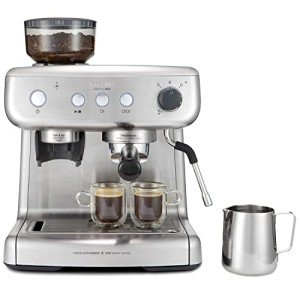The Ultimate Guide to Cappuccino Machines: Brewing the Perfect Cup
Coffees are a precious coffee beverage that integrates the abundant tastes of espresso with steamed milk and milk foam. For lots of, absolutely nothing tastes much better than a homemade cappuccino crafted with accuracy. However, reproducing the ability of a barista at home requires the best equipment. This is where cappuccino machines enter play. Espresso Machine Reviews explores the various kinds of cappuccino machines, how they work, and pointers for choosing the best one for your requirements.
What is a Cappuccino Machine?
A cappuccino machine is a specific brewing device created to make cappuccinos and other espresso-based beverages. These machines usually feature a built-in espresso maker, a milk frother, and various controls for changing temperature level and pressure. Cappuccino machines can be manual, semi-automatic, or fully automatic, providing different levels of user control depending on the complexity of the machine.
Kinds Of Cappuccino Machines
1. Manual Espresso Machines
- Description: These machines require users to run most functions by hand, consisting of grinding coffee beans, tamping the premises, pulling the espresso shot, and frothing the milk.
- Pros:
- Offers complete control over the developing procedure.
- Can produce high-quality, café-like espresso.
- Cons:
- Steeper knowing curve.
- Needs more effort and time.
2. Semi-Automatic Espresso Machines
- Description: Semi-automatic machines automate some processes, such as water pressure. Users still need to grind coffee and froth milk manually.
- Pros:
- Balanced control and benefit.
- Allows room for experimentation.
- Cons:
- Still needs useful skills.
- Can be complex for beginners.
3. Completely Automatic Espresso Machines
- Description: These machines automate the whole developing process, from grinding to frothing. Users simply choose the preferred drink.
- Pros:
- Extremely convenient and easy to use.
- Constant outcomes with little effort.
- Cons:
- More costly.
- Restricted control over the developing procedure.
4. Super Automatic Espresso Machines
- Description: Similar to fully automatic machines, however these designs include features like a built-in milk frother and grinder. They prepare beverages with just the touch of a button.
- Pros:
- Ultimate benefit; makes different beverages rapidly.
- Integrated cleaning and upkeep functions.
- Cons:
- High preliminary cost.
- Less hands-on experience with coffee making.
Key Features to Consider
When selecting a cappuccino machine, numerous functions can significantly affect performance and user experience. Here are some essential aspects to examine:
1. Develop Quality
- Materials utilized (stainless-steel, plastic)
- Durability and durability
2. Capacity
- Water reservoir size
- Bean hopper capability
3. Frothing Capability
- Kind of frothing wand (manual, automatic)
- Steam pressure and temperature control
4. Alleviate of Use
- User-friendly controls
- Cleaning and maintenance requirements
5. Price
- Range from budget to high-end models
- Consider guarantees and customer support options
6. Brand name Reputation
- User reviews and expert opinions
- Accessibility of replacement parts
The Brewing Process
To brew the ideal cappuccino in your home, follow this procedure, despite the machine type:
- Prepare the Espresso: Use newly ground coffee beans and pull a double shot (around 2 ounces) of espresso.
- Froth the Milk: Steam fresh milk to a temperature level about 150 ° F( 65 ° C)using the steam wand or automatic frother.
- Integrate: Pour the steamed milk over the espresso, followed by a layer of milk foam (equal parts espresso and steamed milk, with about 1 cm of foam).
For a visual representation, here's an easy table comparing the characteristics of the cappuccino machine types:
| Machine Type | Control Level | Reduce of Use | Rate Range | Ideal For |
|---|---|---|---|---|
| Manual Espresso Machine | High | Difficult | Low to Medium | Coffee lovers, purists |
| Semi-Automatic Machine | Medium | Moderate | Medium | Home baristas, enthusiasts |
| Fully Automatic Machine | Low | Easy | Medium to High | Casual drinkers |
| Super Automatic Machine | Extremely Low | Extremely Easy | High | Hectic specialists |
Often Asked Questions (FAQs)
What is the very best milk to use for cappuccinos?
Entire milk is typically chosen for frothing due to its fat content, which produces a creamy texture. Nevertheless, options like almond milk, oat milk, or soy milk can be utilized, though they might require various frothing techniques.
How do I tidy my cappuccino machine?
A lot of machines feature particular cleansing directions. Generally, you should frequently clean up the group head, steam wand, and drip tray. For automatic machines, numerous models feature self-cleaning cycles.
Can I use pre-ground coffee instead of entire beans?
Yes, you can use pre-ground coffee. Nevertheless, newly ground coffee typically produces a more delicious espresso due to the oils in the beans being maintained.
How much should I spend on a cappuccino machine?
The cost varies considerably based on features, brand name, and quality. A standard, great quality machine might begin around ₤ 200, while high-end very automatic machines can surpass ₤ 2,000.
How often should I change my cappuccino machine?
With correct maintenance, a high-quality cappuccino machine can last for several years. However, you might consider upgrading if you discover your machine no longer meets your developing requires or experiences performance problems.
Cappuccino machines are effective allies in delivering the ideal brew at home. Whether you favor manual interaction with your coffee or prefer the benefit of completely automated machines, comprehending the various types and their features will assist you in making the ideal choice. By purchasing the perfect machine for your needs and using the right strategies, anybody can take pleasure in a barista-quality cappuccino from the convenience of their own cooking area. With a little bit of patience and creativity, the art of cappuccino brewing can become a wonderful routine, brewing not simply coffee however moments of joy.

